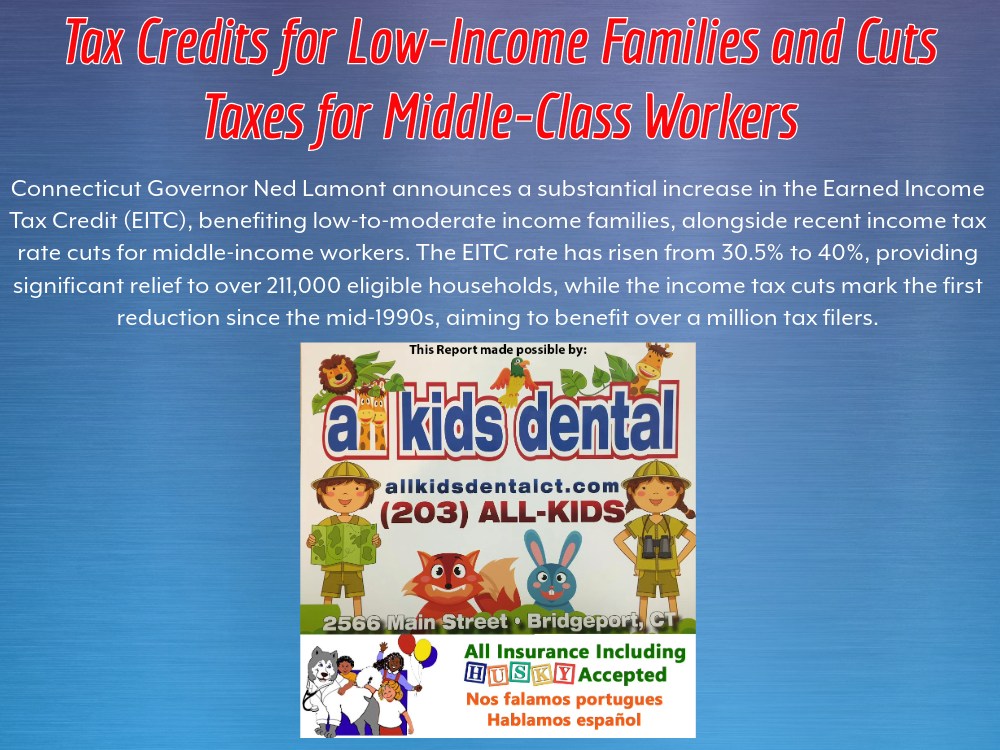Newly Enacted Rate Change in the Earned Income Tax Credit Comes in Addition to the Recent Cut in Income Tax Rates for Middle-Income Workers (HARTFORD, CT) – Governor Ned Lamont today is reminding Connecticut residents that thousands of low-to-moderate income individuals and families in the state are eligible to receive a significant boost in tax credits when they file their personal income tax returns this year due to a newly enacted rate change in the Connecticut Earned Income Tax Credit (EITC), which has increased from the most recent rate of 30.5% for the 2022 income year to the new rate of 40% for the 2023 income year.

The rate change – which was enacted as a result of the state budget bill that the legislature approved and Governor Lamont signed into law last year and which also includes several other significant tax relief measures – means that lower-income filers will receive several hundred dollars in additional tax credits this year above what they received the prior year, depending on their income and number of dependents. Typically, more than 95% of filers who receive this credit have families with children. “Increasing the rate of the Connecticut Earned Income Tax Credit is one of the most impactful provisions in the recently enacted state budget because it will provide direct relief to low-to-moderate income workers who are providing for their families,” Governor Lamont said. “Numerous studies have shown that this tax credit is one of the best anti-poverty tools we can use because it encourages work, boosts economic stability, and uplifts generations to come. Ultimately, these tax credits improve entire communities because these dollars are being invested right back into our local economy through groceries, transportation, clothing, rent, utilities, and other necessary expenses. I want to make sure Connecticut’s working families know about this tax credit and claim it.” “The Department of Revenue Services is proud to administer the Earned Income Tax Credit, as it provides direct relief to working families across Connecticut,” Connecticut Department of Revenue Services Commissioner Mark Boughton said. “Our dedicated DRS staff are happy to help all taxpayers who qualify for this credit to claim it on their tax returns. Additionally, individuals who qualify may utilize assistance from the Volunteer Income Tax Assistance Program.” The Connecticut EITC is based on the amount of the federal EITC. It is available to those earning less than: $56,838 ($63,698 married filing jointly) with 3 or more qualifying children $52,918 ($59,478 married filing jointly) with 2 qualifying children $46,560 ($53,120 married filing jointly) with 1 qualifying child $17,640 ($24,210 married filing jointly) with no qualifying children It is estimated that approximately 211,000 households in Connecticut are eligible. The Connecticut EITC was created in 2011 and has had varying rates over the last decade, including 30% in 2012, 25% in 2013, 27.5% from 2014 to 2016, 23% from 2017 to 2020, and 30.5% in 2021 and 2022. This new 40% rate makes Connecticut among the top five states in the nation with the largest EITC rates. EITC rate increase comes in addition to the income tax cut for middle-income households that took effect January 1, 2024 In addition to the rate change in the Connecticut EITC, the state budget bill that Governor Lamont signed last year includes cuts to the state’s income tax rates that are targeted toward providing relief to middle-income households earning less than $150,000 for single filers and $300,000 for joint filers. Those cuts, which went into effect on January 1, 2024, reduced the two lowest rates of the state’s progressive tax structure by: Decreasing the rate on the first $10,000 earned by single filers and the first $20,000 by joint filers from 3% to 2%; and Decreasing the rate on the next $40,000 earned by single filers and the next $80,000 by joint filers from 5% to 4.5%. This is the first time that income tax rates have been cut in Connecticut since the mid-1990s. It is also the single largest income tax cut enacted in state history. The income tax cut is estimated to benefit more than one million tax filers.
